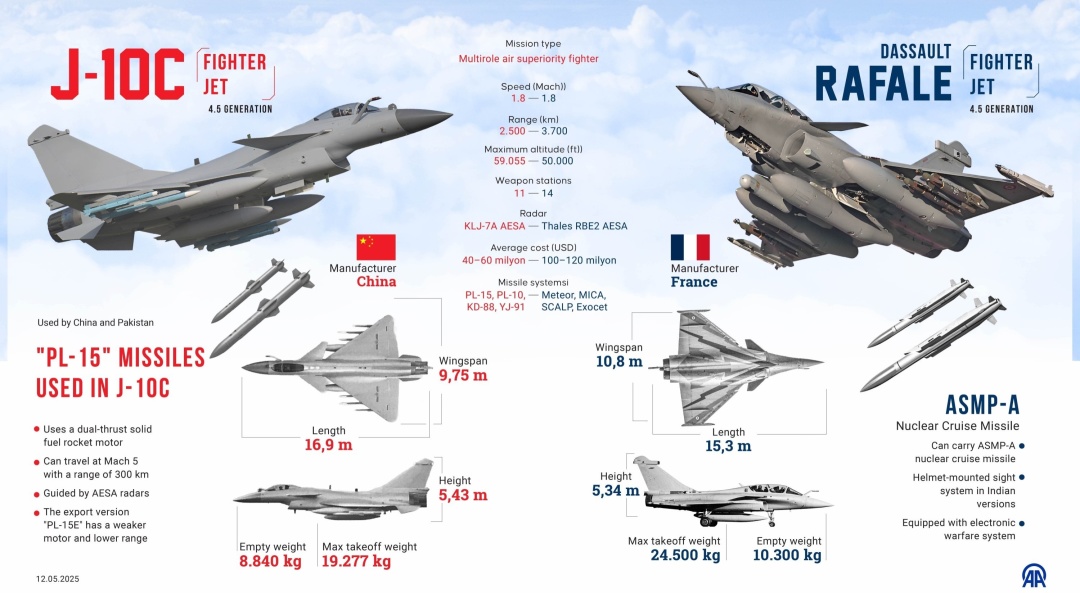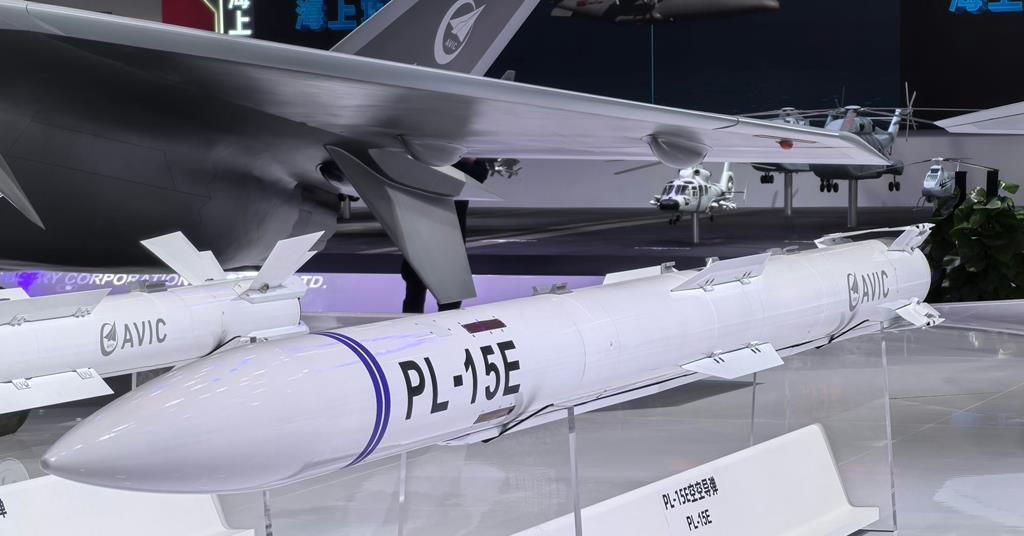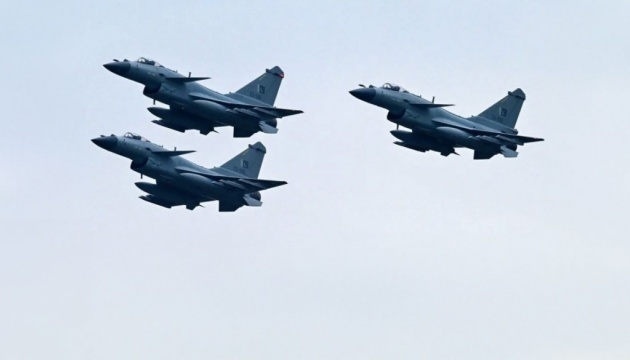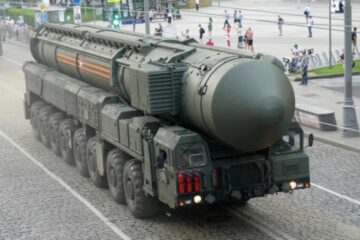The Indo-Pakistani “three-day war” became a testing ground for China’s latest weapons. What lessons can Ukraine learn from this?
The latest conflict between India and Pakistan lasted a few days, but has already gone down in history as one of the greatest air battles of our time, attracting a great deal of attention from defense analysts throughout the world. In addition to the political and territorial implications, it highlighted another important aspect, that is, the first ever large-scale combat deployment of Chinese weapons systems, in particular the JF-17 Block III and J-10C fighters, the PL-15E air-to-air missiles, as well as the HQ-9, HQ-16 and HQ-7 air defense systems.
For China, which has not participated in major wars for more than four decades, but is rapidly ramping up its defense-industrial capacities, this has turned into a kind of “baptism by war” for its export products. Beijing has long referred to Islamabad as its Iron Brother, and, according to the Stockholm International Peace Research Institute (SIPRI), about 81 percent of the weapons imported by Pakistan over the past five years were Chinese-made. These are modern fighter jets, missiles, radars, and air defense systems that were supposed to show off their effectiveness in real combat confrontation.
The Chinese Dragon is spreading its wings: from reverse engineering to indigenous developments
Oleksandr Kovalenko, defense analyst at the Information Resistance think tank, having analyzed the situation, notes: “Indeed, over the past two decades, the PRC has made an impressive leap forward, having transformed from a country that used to manufacture weapons and defense technologies largely by way of reverse engineering into a potent manufacturer of indigenously designed technologies. The expert emphasizes: “At the initial stage, the Chinese defense-industrial sector relied mostly on copy-paste — first Soviet-designed models, then Russian ones, followed by modifications of Western-developed systems. And on the basis of these reverse engineered copies, China has built a powerful defense industry, which now produces weapons of own indigenous designs.”
According to Kovalenko, “China ensures its advantages by way of integrating domestic production of microelectronic and large-scale industrial potential with relatively cheap labor. This enables it to create high-tech products that can compete with Western counterparts in terms of functional characteristics, but come at a far lower cost.” Nowadays, the analyst believes, “China manufactures a full range of weapons ranging from ground warfare and air warfare systems to naval and specialized systems, which often rival in quality and performance French, British, German or American counterparts.” However, as Mr. Kovalenko notes, the key question that still remains open is reliability: “It is precisely the operational reliability of Chinese weapons systems that experts have the most questions about.” Well, the Kashmir conflict will at least partially answer this question.
At the same time, Pavlo Lakiychuk, head of security programs at the Center for Global Studies “Strategy XXI,” highlights the fact that, for Beijing, the aforementioned conflict became not just an opportunity to demonstrate the value of its military technologies, but also a kind of advertising campaign: “Obviously, it was China who has won the “three-day war” between India and Pakistan, actually. And this is not about the combat clashes proper, but about information support for them. Beijing exploited the conflict to advertise its weapons. Advertise not on exhibition stands, but on the real battlefield — the right move for one of the largest arms exporters in the world – “advertising is the engine of trade.”
According to publicly available sources, Pakistan has been intensively using Chinese JF-17 Thunder and J-10C Vigorous Dragon fighters. In particular, the Pakistani side claimed to have shot down several Indian fighters, including a French-built Rafale. Some analysts suggest that the Chinese PL-15 air-to-air missiles, capable of ranges of 200-300 km, supposedly played a major role in this.
Technology or tactics: what was decisive in the air battles over Kashmir?
The question of the effectiveness of Chinese weapons has become a key one in the “post-conflict” discussions. Were they really that advanced, or were there other factors of Pakistan’s successes?
In this context, Oleksandr Kovalenko draws attention to the human factor and tactical training: “I saw reports about the poor actions by the Indian aviation… Indeed, you can be a pilot of the most modern and expensive fighter, but without proper training and experience this does not guarantee superiority in air combat through a purely technological edge. This is a long-known truth: the decisive factor is not only the equipment, but also the quality of the pilot’s training, his ability to work in real combat conditions.” Analyzing the losses suffered by the Indian side, which, according to some reports, lost three Rafale fighters, one Su-30MKI and one MiG-29, Kovalenko concludes: “Such significant losses were not caused by the enemy’s technological superiority, but the competent construction of tactics by Pakistan, whose military was able to build an effective air combat strategy that allowed them to impose their conditions on the enemy.” The analyst says that, though “the Rafale is a modern, high-tech fighter, ranked one of the best in the world,” its high cost (about $250 million per airplane, including weapons and maintenance infrastructure) proved not a guarantee of victory. “By way of comparison, the Pakistani JF-17 Block 3, produced in a collaboration with China, comes at a cost of just about $40 million,” the expert emphasizes.

That said, “India’s superiority in cost terms has not translated into superiority on the battlefield. Pakistan used relatively cheap platforms, but thanks to competent organization of the battle, creation of risk zones with the help of air defenses, as well as accurate forecasting of the routes of Indian airplanes, it managed to achieve the desired result. Islamabad used a limited number of fighters — half as many as India did — with high effectiveness and efficiency, while having suffered no confirmed losses against the adversary.”
Mr. Kovalenko sums this up thus: “This was one of the greatest air confrontations in modern history, and Pakistan, undoubtedly, emerged from it as a winner. India, in the contrary, suffered significant technical and reputational losses, despite its numerical and technological superiority. This case proves once again: in an air battle, not only technology decides, but also tactics, coordination and combat experience.”
Pavlo Lakiychuk shares this opinion: “As regards the air battle between the Indians and the Pakistanis, there are many questions arising about it. Better “hardware” and its quantity comprise only one of the components to victory in battle. The factors that are no less important, and sometimes decisive, are the strategy and chosen tactics, the training of the personnel and the level of their morale and combat motivation and performance. It is not necessary to tell this to the Ukrainians – we have known this for three years now, even those who did not want to understand, have realized this.” The expert notes that “both sides were very cautious in the battle. Whether this was due to a lack of confidence in their own strength or other factors is difficult to say. But whatever, the Pakistani pilots, all things being equal, have faired better.” However, the analyst warns against hasty conclusions about the absolute superiority of Chinese technology: “Does this mean that Chinese weapons are better? No, not necessarily. But it means that the Indian pilots who took part in the battles were less well-trained. They do not know enough about characteristics and performances of hostile detection systems and weaponry, neither do they have enough experience in applying theoretical concepts to real-world combat situations.”
At the same time, Lakiychuk emphasizes: “But it is not worth evaluating Chinese weapons as “cheap shlock.” Long gone are the years when Chinese weapons were reverse-engineered copies of Soviet-designed and other weapons. In a number of technology areas, the Chinese are already ahead of their competitors. At the same time, being focused on arming their own armed forces and expanding their defense export capabilities — they do not make the prices too high. As a result, they have a double win.”
Valery Ryabykh, business development manager at the news and consulting company Defense Express, provides more specific data on the scope and extent of the air battle: “Regarding one of the greatest air battles since World War II, which took place during the armed confrontation between India and Pakistan, we can rely on information from diverse sources. It is noted that this battle involved a total of approximately 130 aircraft of the air forces of India and Pakistan. This was, assumingly, the greatest air battle in modern history.” Mr. Ryabykh clarifies that “major events took place beyond line of sight, along a very extended frontline of about 750 km long, as estimated by observers, the extent is impressive, indeed.” As regards the losses suffered, the analyst says: “Pakistan officially stated that a great number of Indian aircraft were shot down. The reports refer to two Soviet-designed airplanes – one MiG-29 and one Su-30MKI. At least one Rafale was also confirmed to have been shot down, but the Pakistanis claim to have shot down three such fighters, and have even published evidence.” The expert highlights the role Chinese technology played in these successes: “Observers attribute such successes precisely to the use of Chinese JF-17 airplanes, as well as the J-10, which, according to observers, played a decisive role in shooting down the Rafale jets. The use of Chinese air defense systems supposedly also contributed to the success of the Pakistani side. The use of the Chinese-built PL-15 missile, which is credited with shooting down the Rafale fighters, is also noted. Certainly, the lack of data on these missiles reduces the effectiveness of the countermeasures. Accordingly, everyone in the world took notice of the results of this air battle.”
It is worth noting that the Indian Air Force relied on the Dassault Rafale – a French multirole 4++ Gen fighter aircraft equipped with a wide range of weapons and intended to perform air supremacy, interdiction, aerial reconnaissance, ground support, in-depth strike, anti-ship strike and nuclear deterrence missions. Pakistan, in turn, used the lighter and cheaper JF-17 Thunder it developed in a collaboration with China, and the more advanced Chinese-built J-10C. Though the Rafale is considered more technologically advanced, the air battles over Kashmir demonstrated how domestic technologies can be used to best effect and ultimately prevail. Sources claim that the J-10C, equipped with active phased array radars (APAR) and highly capable missiles, proved to be a serious opponent to the Rafale jet.
Lessons to be learned by Ukraine and the Future of Military Technology
The experience of the Indo-Pakistani conflict also holds important lessons for Ukraine. Oleksandr Kovalenko draws parallels with the Russian-Ukrainian war: “The air confrontation over Kashmir has brilliantly demonstrated the trend that we have already observed in Ukraine. In 2022, it became obvious from the Ukrainian battlefields that tanks — even the most advanced ones — ceased to play a decisive role on the battlefield. Their effectiveness had significantly decreased due to the massive use of anti-tank missile systems… Over time, the situation on the battlefield ultimately changed with the coming of FPV drones — cheap, highly mobile, and used in massive quantities.” The expert continues to comment: “A similar situation has developed at sea. Ukraine, without having a full-fledged naval fleet or even a flotilla, managed to impose its control over the Black Sea waters using unmanned naval weapons… This all is indicative of one thing: the future lies in unmanned, remotely controlled systems. They are evolving into a decisive factor in modern warfare.”

The example of Kashmir, Oleksandr Kovalenko believes, only confirms this: “Pakistan, having gained an access to relatively inexpensive fighters, has built an effective tactical model of combat and won an advantage over the Indian military, equipped with ultra-modern and ultra-expensive Rafale jets. This once again proves: in war, higher cost doesn’t always mean higher effectiveness.”
Mr. Kovalenko continues to comment: “This all makes us give thought to the future of manned combat aviation. If a modern fighter jet worth hundreds of millions of dollars can be neutralized or forced out of combat by an unmanned system that is tens or even hundreds of times cheaper, then the feasibility of such investments is becoming increasingly questionable. Future warfare will be drone warfare, rather than warfare of expensive human-piloted platforms.”
Pavlo Lakiychuk comments: “European companies should absorb the experience gained in combat by Ukraine. And the Indo-Pakistani conflict is an indirect confirmation of this. For the past thirty years, “wealthy” Western arms manufacturers have been developing and producing sophisticated high-tech, highly valuable weapons products”. The experience we have gained suggests that, in a protracted massive war, characteristics such as ease of operation, maintainability, interchangeability, and endurance matter no less, and sometimes even more than high physical and performance parameters. The Chinese (and not only the Chinese) have chosen to follow this path. This makes the weapons systems offered by China more appealing to potential customers, especially from the Global South.”
In this context, potential cooperation between China and the Russian Federation in the defense sector is particularly concerning. Oleksandr Kovalenko expresses hope that “the PRC will not provide the Russian Federation with direct military assistance, including the supply of weapons, military equipment – neither land, nor air, nor any other. After all, this would create much more dangerous challenges for us. That is why Ukraine must act cautiously and thoughtfully in relations with China so that to preclude Beijing transitioning to providing direct military support for Moscow.” If Beijing moves to exporting defense products to the Russian Federation on a large scale, this could dramatically change the balance of power and create an extremely dangerous situation for Ukraine and its partners.”
Conclusion notes
Hereby, the “three-day war” between India and Pakistan has not provided a definitive answer to the question of whose air force capabilities are better. However, it clearly demonstrated that, in modern air combat, technology is just one component to success. Competent tactics, the level of pilot training, the effective use of intelligence and electronic warfare assets, as well as integration and coordination with other armed services play no less, and perhaps even more decisive roles. Chinese weapons have certainly passed an important test and have proved themselves as a serious competitor on the world market. But the battle in the skies over Kashmir is more about how David can successfully confront Goliath not only with physical weapons but with the ability to use them to best effect and the knowledge of the enemy’s weak spots. And this is perhaps the most important lesson to be learned by both New Delhi and Islamabad, as well as by Kyiv.
Myroslav Liskovych. Kyiv
Source: Indo-Pakistani air battles over Kashmir: Lessons to be learned by Ukraine




